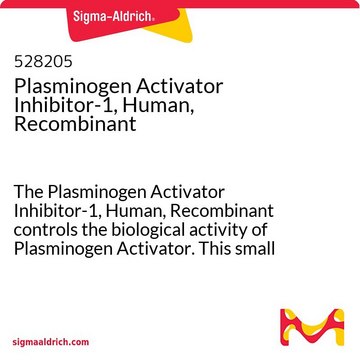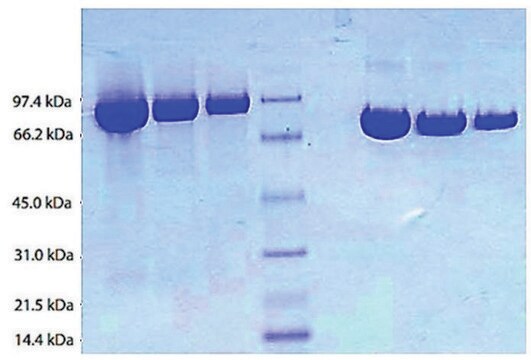Wszystkie zdjęcia(1)
Key Documents
T2943
Tissue plasminogen activator chromogenic substrate
≥95% (HPLC), solid
Synonim(y):
TPA Activity Assay
Zaloguj sięWyświetlanie cen organizacyjnych i kontraktowych
About This Item
Polecane produkty
Poziom jakości
Próba
≥95% (HPLC)
Postać
solid
masa cząsteczkowa
apparent mol wt 658.9
rozpuszczalność
methanol: water (1:9): 25 mg/mL
temp. przechowywania
2-8°C
Opis ogólny
Tissue plasminogen activator chromogenic substrate is a highly sensitive chromogenic peptide substrate for tissue plasminogen activator (tPA). It shows different sensitivity to native single-chain tPA (sc-tPA) and its fully active two-chain form (tc-tPA).
Zastosowanie
Tissue plasminogen activator chromogenic substrate has been used:
- in tissue plasminogen activator inhibition assay
- to determine the plasminogen activator (PA) activity by studying the glycosylation properties of tissue plasminogen activator (tPA) activities in effusions using concanavalin A-Sepharose (conA-S) chromatography
- in inhibition assays and complex formation analyses of wild type (WT) neuroserpin (NS) and its variants
This page may contain text that has been machine translated.
Kod klasy składowania
11 - Combustible Solids
Klasa zagrożenia wodnego (WGK)
WGK 3
Temperatura zapłonu (°F)
Not applicable
Temperatura zapłonu (°C)
Not applicable
Środki ochrony indywidualnej
Eyeshields, Gloves, type N95 (US)
Certyfikaty analizy (CoA)
Poszukaj Certyfikaty analizy (CoA), wpisując numer partii/serii produktów. Numery serii i partii można znaleźć na etykiecie produktu po słowach „seria” lub „partia”.
Masz już ten produkt?
Dokumenty związane z niedawno zakupionymi produktami zostały zamieszczone w Bibliotece dokumentów.
Mahdieh Bayat et al.
Journal of biotechnology, 280, 1-10 (2018-05-29)
The aim of the present study was to investigate the effect of three routine drug excipients, as osmolytes, in three different concentrations, on structure, thermal stability and the activity of single-chain (sc-) tenecteplase. To see the influence of trehalose, mannitol
Mohammad Farhan Ali et al.
Scientific reports, 7, 42987-42987 (2017-02-24)
Neuroserpin (NS) mediated inhibition of tissue-type plasminogen activator (tPA) is important for brain development, synapse formation and memory. Aberrations in helix F and β-sheet A movement during inhibition can directly lead to epilepsy or dementia. Conserved W154 residue in a
Jesse Cahill et al.
Frontiers in molecular biosciences, 7, 574477-574477 (2020-10-08)
Although chemically inert, Xe and other noble gases have been shown to have functional effects on biological systems. For example, Xe is a powerful anesthetic with neuroprotective properties. Recent reports have claimed that Xe inhibits the activity of tissue plasminogen
Mahdieh Bayat et al.
International journal of biological macromolecules, 130, 863-877 (2019-03-09)
Organic osmolytes, as major cellular compounds, cause protein stabilization in the native form. In the present study, the possible chaperone effects of the three naturally occurring osmolytes on the two-chain form of tenecteplase (tc-TNK), a recombinant, genetically engineered mutant tissue
Deepa Gautam et al.
Frontiers in cell and developmental biology, 10, 834016-834016 (2022-04-08)
Prion peptide (PrP) misfolds to infectious scrapie isoform, the β pleat-rich insoluble fibrils responsible for neurodegeneration and fatal conformational diseases in humans. The amino acid sequence 106-126 from prion proteins, PrP(106-126), is highly amyloidogenic and implicated in prion-induced pathologies. Here
Nasz zespół naukowców ma doświadczenie we wszystkich obszarach badań, w tym w naukach przyrodniczych, materiałoznawstwie, syntezie chemicznej, chromatografii, analityce i wielu innych dziedzinach.
Skontaktuj się z zespołem ds. pomocy technicznej








